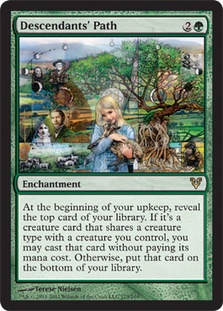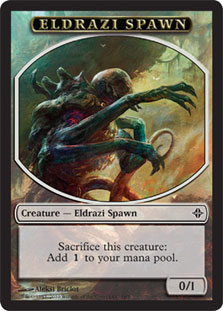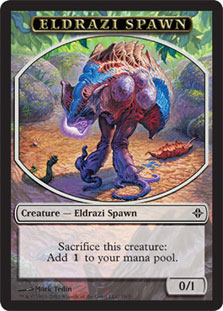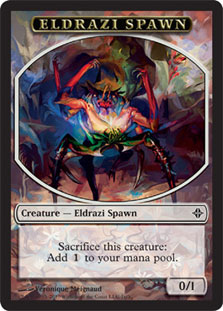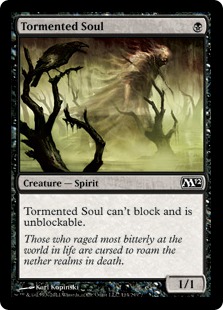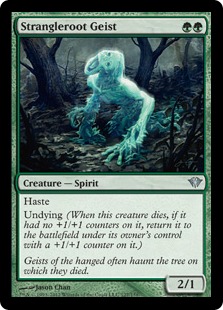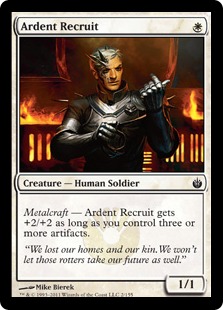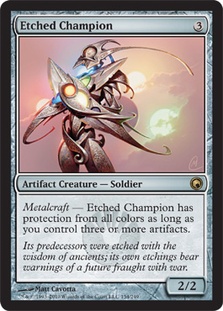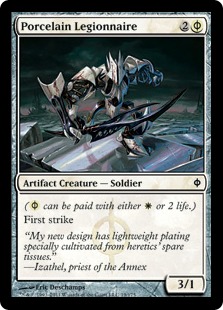I met this blond-haired girl about a month and a half ago. She’s been driving me crazy ever since.
Some ink’s been spilled on Descendants’ Path being a force in Legacy and Modern, but what about Standard? Sure, Emrakul, the Aeons Torn is the obvious “top card of choice,” but the little girl is holding a lamb, not an Eldrazi Spawn from one of the brood lineages.
“Faces only a Broodwarden could love.”
In Avacyn Restored Standard, there are 94 creature types that occur on the castable sides of creature cards, from Advisor to Zombie. (This figure doesn’t include specialty creature types, such as the Pentavite made by Pentavus and the flipside Mutant aspect to Homicidal Brute, that appear on cards but cannot trigger a free casting from Descendants’ Path.)
In the absence of the library manipulation that gives Descendants’ Path its Legacy potential, the key to an effective Standard Descendants’ Path deck will be using it as a card advantage engine instead, delivering creature after creature off the top of the library. This implies heavy commitments to both large numbers of creatures and a single creature subtype; without a critical mass of both, Descendants’ Path is unlikely to pay back what the player has invested in it.
Some fun facts about those creature types, courtesy of the handy-dandy spreadsheet:
Nineteen of the creature types appear on only one card. Sorry to all you fans of Archons and Avatars, Crabs and Crocodiles, Salamanders and Specters… It’s not happening.
Only 37 creature types appear on the fronts of six or more Standard-legal creature cards. (I chose this number to give at least six times four or 24 creatures in a deck.) Berserker and Griffin squeak in, while Druid, Elephant, Ogre, Praetor, Shapeshifter, Snake, Sphinx, Treefolk, and Vedalken end up on the wrong side of the cutline.
Of the eleven most prevalent creature types, six are “species” (Human, Zombie, Spirit, Vampire, Horror, Angel) and five are “occupations” (Warrior, Soldier, Cleric, Wizard, Shaman). Angel and Shaman are tied for tenth place at 23 appearances each. Honorable mentions go to three further species: Beast (21 appearances) and Construct and Myr (both with twenty appearances).
Let’s Talk About Decks, Baby*
(A few notes before we get to the decklists: most of these are untested “concept decks” to show what might be possible. In each case, Descendants’ Path is the only noncreature, nonland card I’ve allowed; that feels largely unsustainable in competition, even at the FNM level.)
Now that we have a solid list of viable creature types, Humans is the obvious place to start; not only does it have the largest pool of potential creatures (168, more than three times that of nearest competitor Zombie), but it also has a sizable presence in Descendants’ Path’s color, green. Here’s a Magic Online Daily take:
Creatures (33)
- 4 Hero of Bladehold
- 3 Fiend Hunter
- 4 Champion of the Parish
- 4 Avacyn's Pilgrim
- 4 Mayor of Avabruck
- 3 Thalia, Guardian of Thraben
- 4 Silverblade Paladin
- 4 Champion of Lambholt
- 3 Nearheath Pilgrim
Lands (11)
Spells (16)

This deck gives up the Champion of the Parish + Gather the Townsfolk draw for Champion -+ Mayor of Avabruck, which is far spicier in its own way. I’m not sure about the Nearheath Pilgrim slot (Hamlet Captain is legal), but otherwise it’s a close-to-ideal W/G build. I’ve also experimented with a Naya build that’s close to one of Brian Kibler numerous takes, but the mana is too finicky for my taste.
Using Descendants’ Path in the “cheat out a larger creature” sense falls flat for Standard-legal Humans. The biggest Human bodies belong to Geist-Honored Monk (a possible inclusion in the W/G build) and its ilk. Specialty cards such as Zealous Conscripts could come into play, but what’s the highest total power and toughness a player is guaranteed? Seven from Maul Splicer? That’s not good enough.
Now what? If Humans has only a tenuous hold on a proper Descendants’ Path deck, what hope does any other creature type have? More than you might think, it turns out.
Warriors, Come Out to Play!
The pool of Warriors is far smaller than that of Humans (just 44 versus 168), but there’s plenty of power available, including some special green cards. Champion of Lambholt? Human Warrior. Wolfir Silverheart? Wolf Warrior. Glistener Elf? Elf Warrior. (Glistener Elf and Wolfir Silverheart doing the Joint Assault tag-team thing? Yeah, it’s nasty.)
Because Glistener Elf is the only one-drop Warrior in green, though, I’m recruiting red, which adds some toys of its own…
Creatures (33)
- 4 Glistener Elf
- 4 Goblin Fireslinger
- 3 Hamlet Captain
- 3 Zealous Conscripts
- 4 Wolfir Silverheart
- 4 Champion of Lambholt
- 4 Wolfir Avenger
- 4 Kruin Striker
- 3 Somberwald Vigilante
Lands (12)
Spells (15)

Once again, the mana causes trouble; trust me, I’d rather have Goblin Wardriver over Hamlet Captain, but you’re a better builder than I am if you can make first turn G, second turn RR, third turn 1GG work consistently in this Standard environment! The two-drop slot is pretty bare (it’s too bad Stormblood Berserker is a Berserker rather than a Warrior), and one of the keys to a Standard-legal Descendants’ Path deck is having a range of options at each converted mana cost. Even so, this concept might be worth exploring, if only to have an excuse to practice your taunting falsetto at FNM.
The Next Thing on My List
The rest of the creature types pose significant problems for building a dedicated Descendants’ Path deck but may be only one or two cards away from breaking through. These cards may be creatures or new enemy dual lands.
Zombies (53 creatures): Zombies may be the second-largest creature type in the current Standard, but the inevitable mana requirements (exceeding heavy on the black, naturally) wreck an otherwise amusing possibility. The Zombie Pod deck is cool, but it never has to spend green mana if it doesn’t want to. The blond girl and her lamb are a bit pickier, and Zombies won’t put up with that. They’ll just mutter about brains amongst themselves and shuffle away.
Spirits (41 creatures): The incorporeal menace suffers from a lack of one-drops, and there aren’t many friends in green for Strangleroot Geist.
Soldiers (40 creatures): Almost all of the Soldiers are also Humans, covered above, and as much as I’d like to make an Ardent Recruit + Etched Champion + Porcelain Legionnaire “Toy Soldiers” deck work, there just isn’t enough support for an artifact Soldier subtype.
Vampires (37 creatures): Any decent deck would have to go the full Jund spectrum, cope with a single one-drop Vampire (albeit a quality one in Stromkirk Noble), and try to ramp up to Chancellor of the Dross.
Clerics (33 creatures): Now this is an interesting possibility. Including Phyrexian Metamorph goes against the one-type-only rule, but it allows for the Suture Priest + Leonin Relic-Warder + Phyrexian Metamorph lifegain loop (which, sadly, isn’t all that impressive anymore with the introduction of Kessig Wolf Run to Inkmoth Nexus). There’s a decent base of small Clerics in white and even a topdeck chainer with Brutalizer Exarch, but the quality heavy-hitter, Mikaeus, the Unhallowed, calls for triple-black. Good luck there.
Wizards (32 creatures): This profession has the low curve but not the high, and the most-played one-drop Wizard of Standard is Delver of Secrets, a nonbo with Descendants’ Path if I’ve ever seen one.
Horrors (29 creatures): While there’s a dearth of one-drop Horrors (though Fume Spitter is no slouch), look at that slate of two-drops! Phyrexian Revoker and especially Spellskite have their uses, and Plague Stinger can fill in for a bit of infectious fun. Going the infect route, high-curve Horrors include Phyrexian Vatmother, Putrefax, and Phyrexian Swarmlord. Sadly, Phyrexian Obliterator would be almost exclusively a “cheat-out” card because only Woodland Cemetery can help cast third turn Descendants’ Path and fourth turn Phyrexian Obliterator in the current Standard.
Angels (23 creatures): The curve starts at three, and while a Descendants’ Path Angels deck would be spicy once it gets going, it’d be incumbent on the Angels deck to survive the early going. I’ve tried to solve this one, but a quick Delver start just dismantles all of my attempts. Could Chancellor of the Annex find its niche here?
Shamans (23 creatures): From one-drops such as Goblin Arsonist and Ulvenwald Tracker to curve-toppers including Thrun, the Last Troll, the Shamans offer a stocky selection. The top of the curve is far iffier, though a Descendants’ Path shell might be the ticket to making Skinshifter and Rage Thrower Constructed-relevant.
Beasts (21 creatures): Beasts define the ideal top-curve, thanks to heavy hitters such as Craterhoof Behemoth and Garruk’s Horde. There’s also more at the bottom than one might think, but the three Beasts with converted mana costs under three cost R (Furnace Scamp), GG (Garruk’s Horde), and UU (Plated Seastrider). That’s a tall order to fill, and even the three-drop Beasts are restricted to Cystbearer and Ferrovore.
Constructs (20 creatures): Once more, the low end of the curve is thin (Memnite, Slag Fiend, Haunted Guardian), yet the high curve sports hits such as Kuldotha Forgemaster and Myr Battlesphere. Slag Fiend is a bit misleading here, as it’s secretly a lategame card that happens to cost one mana. Adaptive Automaton is a natural Lord for this group; you might as well name Myr for the Battlesphere. Speaking of…
Myr (20 creatures): There are precisely three converted mana costs represented among the Myr of Scars block: two, three, and seven. There isn’t enough heavy hitting here, though Myr Galvanizer is a nice bonus and Myr Superion is far more playable than usual thanks to all the mana-Myr hanging around.
The Little Bits
As all Werewolves (nineteen creatures) are also Humans, a specifically Werewolf deck would have to incorporate Full Moon’s Rise or similar effects to be worth playing; I’d keep my eye on it for the future. Insects (fifteen creatures) have a curve that begins at two except for Hex Parasite, but it ramps up to Vorapede, Phyrexian Swarmlord, and Moldgraf Monstrosity…not exactly chopped liver. Demons (thirteen creatures) and Dragons (twelve creatures) lack the needed early drops, but the curve-topping power is as impressive as expected.
The real surprise comes from Devils. Just eleven creatures strong in Standard, these malevolent red rapscallions pack a surprising punch up and down the line. For my last deck, I’ll break one of my rules about spells other than Descendants’ Path:
Creatures (30)
- 2 Charmbreaker Devils
- 4 Pitchburn Devils
- 4 Flayer of the Hatebound
- 4 Hellrider
- 4 Forge Devil
- 4 Torch Fiend
- 4 Vexing Devil
- 4 Scalding Devil
Lands (8)
Spells (22)

Likely this build is too loopy and rangy to work out, but a more refined version, likely with fewer creatures, could be a fun FNM deck with its constant stream of damage. I’m not sold on Charmbreaker Devils, but with a few more useful spells beyond looting and the token burn listed above, who knows?
I hope you’ve enjoyed this look at the potential of Descendants’ Path in Standard and come away with at least one fun idea. As always, thanks for reading.
— JDB
@jdbeety on Twitter
*I can’t believe I just made a Salt-N-Pepa reference. I’m too embarrassed to provide the link.

